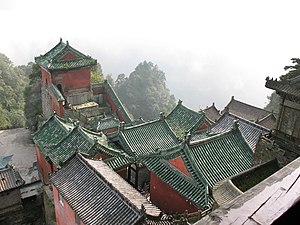The most famous of Kung Fu arts are those hailing from Shaolin. But in China, there is a saying:
"In the north, Shaolin is respected.
In the south, Wudang is revered."
Wudang is most famous for their Taijiquan, which sometimes overshadows the diversity of martial arts found in these secluded mountains. At Wudang the students begin their training with their own styles of traditional wushu (kung fu). These build the necessary skills for children's innate Yang energy, and condition/discipline their hearts and bodies for the world outside the monastery. Realizing the longterm investment and commitment one must have in their Taijiquan practice, students are offered a more external martial art to begin, which slowly teaches the students how to convert this Li force into Qi. Here is the internalization process most martial arts begin to practice after high levels are reached in ranking systems.
The initial stages of the Wudang Gongfu curriculum offered at Hundred Schools of Thought Martial Arts are similar to most styles. Beginning with basic stretches and exercises, the student finds their way into stance work. Along with this are stretching kicks and core strengthening standing postures. After a student is confident in these skills, they move on to learn the basic punching and kicking methods. These are uniquely full-body, and teach the martial artist how to appropriately deliver force. After much practice, the student can begin to use less and less physical force, and more and more internal.
Form training will begin once the basics are covered, starting with Jibenquan. This basic set utilizes a student's need for agility and fluid body motion. All the techniques involved are drilled and practiced with partners for application to appropriately comprehend the style's usage of these movements.
From here, students are then brought into the rotation of currently trained forms. Since each Wudang set can be considered it's own style (within the general basics covered with Jibenquan), the currently trained form is offered to all current students. In some cases students will drill separate forms in the case that the current skill set is too advanced.
Training consists of regular strengthening postures and standing meditation. Courses also include Qigong and breathing skills, necessary for internal martial arts. Regular drilling and reviewing are necessary for students to develop high level skill, along with constant sensitivity training and application work.
Students will be introduced to many methods of skill development and strengthening/conditioning for internalizing their power. Students are requested to practice outside of class regular if they wish to truly develop a high level of skill. But for those looking to learn and grow spiritually, it is in each student's own hands on how much effort and time they wish to put into their own training.
By enrolling in the Wudang Gongfu Core Course, students are welcome to come to any of the classes on the schedule listed as "Wudang Gongfu" which have open enrollment. Details on individual classes will be available upon signing up.
Through private enrollment and semi-private group instruction, the material and curriculum will be developed on a sign up basis. These are structured with the individual's requests in mind.
Current Skill: Fuhuquan
For the Year of the Tiger, the beginning Quanfa (combat system) is Fuhuquan. This is translated as "Tiger Taming Fist." Considered an intermediate form, the power in this system is developed through the ferocity of the martial artist reacting to the attacks of their opponent. Many people also refer to this form as, "Wudang Tiger Style" or an alternative Chinese name of , Xiang Long Fu Hu Quan" translating to "Hidden Dragon Crouching Tiger Form."
It is said this form derives from a village outside of Wudang where tigers were a threat to the villagers and their livestock. This set was developed to help the locals protect themselves and their livelihoods. While a wandering Wudang priest was visiting this village, he learned this skill and introduced it to the Wudang lineage. Since then, it has been reformed and adjusted to fit the Sanfeng Pai basic skills. After generations of practice this form represents the energy needed to deal with such overwhelming force with agility and internal power.
 Image via Wikipedia
Image via Wikipedia Image via Wikipedia
Image via Wikipedia Image by toehk via Flickr
Image by toehk via Flickr Image via Wikipedia
Image via Wikipedia